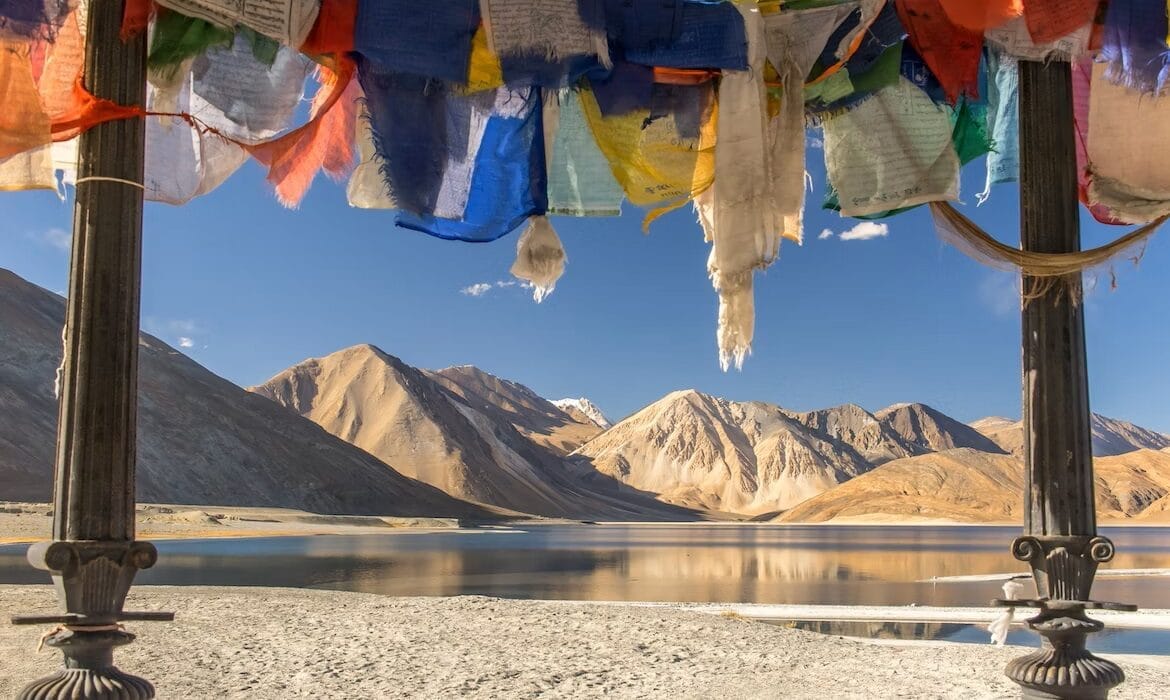Leh Ladakh, settled in the northernmost piece of India, is an entrancing objective that coaxes voyagers from all sides of the world. Leh Ladakh is known for its stunning landscapes, ancient monasteries, and one-of-a-kind cultural heritage. It is also a haven for adventurers and nature lovers. The monsoon season adds an unexpected and enchanting dimension to this high-altitude region, despite the fact that it is frequently associated with cold deserts and barren terrain.
In this outline, we will look at what makes Leh, Ladakh, so appealing during the monsoon season, highlighting the benefits and unforgettable experiences that await brave travelers. A long way from being a chance to stay away from, the storm in Leh Ladakh divulges an entirely different part of the locale, with rich plant life, rejuvenating climate, and energetic social merriments. As we dive into the subtleties, we’ll likewise address the difficulties and safeguards one should consider while leaving on a storm experience in this enthralling area. Thus, let us venture into the core of Leh Ladakh during the rainstorm, and find the secret fortunes that anticipate those able to embrace this strange yet compensating experience.
Advantages of Visiting Leh Ladakh During Monsoon
Visiting Leh Ladakh during the rainstorm season offers a scope of benefits that make it an exceptional and remunerating experience for explorers. In opposition to prevalent thinking, the storm months (July to September) in Leh Ladakh exhibit an alternate side of the locale, making it a brilliant opportunity to investigate. Here are a portion of the key benefits:
Decreased Traveler Group: Dissimilar to the pinnacle vacationer season in summer, the rainstorm sees less guests in Leh Ladakh. This implies you can partake in the quiet and pristine excellence of the locale without the clamoring swarms. The quietness and tranquility of the rainstorm add a specific appeal to the scene, permitting you to interface with nature on a more significant level.

Rich Green Scene: The appearance of storm carries life to the desolate scenes of Ladakh. The once parched and brown mountains change into a lively material of lavish plant life. The contrast between the typical Ladakhi landscape and the lush fields, blossoming flowers, and cascading waterfalls in the rugged terrain is striking.
Reviving and Cool Climate: Leh Ladakh is known for its brutal winters and singing summers, yet during the storm, the weather conditions turns out to be charmingly cool and agreeable. The daytime temperatures stay moderate, making it more agreeable for open air exercises and touring. The cool weather conditions likewise offers alleviation from the outrageous temperatures experienced during different seasons.
One of a kind Celebrations and Social Encounters: Storm in Ladakh is set apart by a few brilliant and energetic celebrations. Dances, cultural events, and traditional celebrations bring the area to life. The renowned Hemis Celebration, celebrated in July, is a stupendous exhibition where local people and sightseers assemble to observe the covered dance exhibitions and strict functions. Encountering these celebrations gives a more profound comprehension of the nearby culture and customs.
Emotional Scenes: The storm changes the scene of Leh Ladakh into a sensational display. The difference of green fields against the tough mountains, interspersed by the reasonable blue skies, makes a sensational and beautiful setting that is a treat for photographic artists and nature lovers.

Overflow of Natural life: The storm season carries transient birds to the area, making it a brilliant time for birdwatching. The lakes and wetlands of Ladakh may have a variety of bird species. Also, the thriving vegetation during this time draws in natural life, expanding the possibilities spotting creatures like marmots, ibex, and yaks.
Photography Amazing open doors: During the monsoon, the unique scenery presents excellent photographic opportunities. The play of light on the newly washed scenes, the impression of mountains in water filled lakes, and the dynamic social celebrations all give enthralling subjects to picture takers.
Overall, going to Leh Ladakh during the monsoon is a refreshing and captivating experience that lets you see the natural beauty and cultural diversity of the area in a way that is very different from other times of the year.
Recommended Places to Visit
Leh Ladakh is a mother lode of charming objections, each offering an exceptional encounter for voyagers. During the storm season, a few spots stand apart for their excellence and openness. Here are a few prescribed spots to visit in Leh Ladakh during the storm:
Religious communities and Authentic Locales:
- Thiksey Cloister: Roosted on a ridge, this famous cloister offers staggering all encompassing perspectives on the encompassing scene and houses noteworthy sculptures and old relics.
- The Hemis Abbey: One of the largest and wealthiest monasteries in Ladakh, it is known for the Hemis Festival and has a large collection of ancient paintings and artifacts.
- Shey Royal residence: The previous regal home, Shey Castle, flaunts a huge gold-plated copper sculpture of Ruler Buddha and offers spellbinding experiences into Ladakh’s set of experiences.

Pangong Lake:
- Pangong Tso, the notorious “high-elevation lake,” is a must-visit objective in Leh Ladakh. Encircled by magnificent mountains, the lake’s hypnotizing shades of blue make a strange and stunning sight. The lake extends across the line into Tibet, adding to its appeal.
Nubra Valley:
- Known as the “Valley of Blossoms,” Nubra is a lavish green valley described by dynamic plantations, sand ridges, and the Shyok Stream. The unique experience of riding double-humped Bactrian camels in the sand dunes is available to visitors.
Magnetic Hill:
- Popular for its attractive properties, this gravity-challenging slope makes an optical deception that causes vehicles to seem to move uphill with no power. A stop at Attractive Slope is a captivating and fun experience.
Lake Tso Moriri:
- Another high-elevation lake, Tso Moriri, is less visited by sightseers, giving a more peaceful setting. The lake is encircled by snow-covered tops, making it a pleasant and quiet area for nature sweethearts.
Monastery of Alchi:
- Alchi Cloister is prestigious for its antiquated wall artworks, models, and engineering magnificence. It is renowned for its distinctive Kashmiri-influenced artwork and is one of Ladakh’s oldest monastic sites.

Zanskar Valley:
- Available during the rainstorm through the amazing Zanskar Waterway journey, the valley flaunts shocking scenes, pleasant towns, and the chance to observe the juncture of Zanskar and Indus streams at Nimmu.
Lamayuru Religious community:
- Lamayuru Monastery, also referred to as the “Moonland of Ladakh,” is perched atop a dramatic landscape and provides a spiritual and peaceful experience.
These are only a couple of the many charming spots to investigate in Leh Ladakh during the rainstorm season. Every location offers an interesting mix of regular magnificence, social importance, and experience, making the excursion through this supernatural land a remarkable encounter.
Adventure Activities during Monsoon
The monsoon months in Leh, Ladakh, offer a variety of thrilling adventure activities for those who are up for the challenge. While an exercises might have restricted admittance because of street conditions and security worries, there are as yet a few choices accessible to capitalize on your visit during this time:
Stream Boating in Zanskar Waterway: Rainstorm carries a flood of water to the Zanskar Stream, making it an ideal time for stream boating. A thrilling adventure awaits adventurers in the Zanskar Valley’s challenging rapids and breathtaking landscapes. Keep in mind that river rafting may only be allowed on certain sections due to safety concerns.
Journeying and Climbing Amazing open doors: Albeit a high-elevation passes might be blocked off because of snow and avalanches, there are as yet a few journeys accessible during the storm. More limited journey like Hoax Valley, Lamayuru to Chilling, or Markha Valley are more secure and can be appreciated with the lavish green view that the downpours bring.

Biking and mountain biking: During the monsoon, cycling and biking are great ways to see the area. The streets may be less packed, and the scene changes into a pleasant view with green valleys and snow-covered tops behind the scenes. However, road conditions and slick surfaces should be avoided.
Investigate Nubra Valley: Nubra Valley, with its twofold bumped Bactrian camels, offers an interesting and gutsy experience. You can take a camel safari through the sand hills, permitting you to observe the magnificence of this valley in a particular manner.
Untamed life Safari: During the rainstorm, the natural life in Leh Ladakh flourishes with the overflow of water and vegetation. You could go on a wildlife safari to look for a variety of animals, like the rare Tibetan wild ass (kiang), marmots, and snow leopards.

Town Visits and Social Drenching: The monsoon season is a fantastic time to get to know the locals and learn about their culture. Partake in the energetic celebrations, taste neighborhood cooking, and find out about their novel lifestyle.
Photography and Touring: The lavish green scenes and novel weather patterns during storm make Leh Ladakh a photographic artist’s pleasure. You’ll have a lot of chances to take stunning pictures of the dramatic scenery in the area.
Kindly remember that security ought to constantly be really important during experience exercises in Leh Ladakh, particularly during the storm. It is vital for really take a look at weather patterns, street openness, and look for direction from nearby visit administrators who are know about the ongoing circumstances to guarantee a protected and pleasant experience.
Cultural Events and Festivals
Leh Ladakh, with its rich social legacy and well established customs, praises a few beautiful celebrations and widespread developments consistently. In any event, during the rainstorm season, there are two significant celebrations that stick out, offering an extraordinary chance to observe and submerge yourself in the nearby culture:
Hemis Festival:
- One of Ladakh’s most well-known and vibrant festivals is the Hemis Festival. The festival honors Guru Padmasambhava, also known as Guru Rinpoche, the founder of Tibetan Buddhism. It is held in the Hemis Monastery, which is the largest and wealthiest monastery in the area. The celebration for the most part happens in June or July, contingent upon the Tibetan lunar schedule.
- The monastery comes to life with spiritual ceremonies, masked dances, and traditional music during the festival. The feature of the occasion is the entrancing Cham dance, where the lamas enhanced in intricate and beautiful covers perform emblematic dance exhibitions. Sightseers and local people the same assemble to observe this stupendous scene, making a dynamic and cheerful air.

Festival in Ladakh:
- The Ladakh Festival is a one-week celebration of the diverse cultural heritage of the region. It is typically held in September, making it one of a handful of the celebrations during the last option a piece of the rainstorm season. Coordinated by the Jammu and Kashmir The travel industry Office, the celebration happens in Leh and encompassing towns.
- The Ladakh Celebration highlights customary music and dance exhibitions, displaying the different ethnic gatherings’ particular practices. Guests can observer people moves, bows and arrows contests, polo matches, and shows of neighborhood workmanship and specialties. The festival is a great way to get to know the locals and experience the Ladakhi people’s welcoming spirit.
Both the Hemis Celebration and Ladakh Celebration offer a vivid encounter into the area’s old culture, giving experiences into their profound convictions, creative articulations, and lifestyle. The lush green landscape that serves as the monsoon backdrop makes these celebrations a one-of-a-kind setting for the event.
It’s vital for plan your visit likewise to concur with these celebrations, as they offer a brief look into the lively and spellbinding social embroidery of Leh Ladakh. Remember that celebration dates might differ somewhat every year, so checking the particular dates for the separate celebrations prior to making your movement arrangements is ideal.
How to Reach
Arriving at Leh Ladakh, arranged in the northernmost piece of India, requires cautious preparation because of its far off area and high elevation. The area is very much associated via air and street, yet travel choices can be restricted during the storm season because of climate related difficulties. How to get to Leh, Ladakh:
By Air:
The most advantageous and famous method for arriving at Leh is via air. Kushok Bakula Rimpochee Air terminal (Leh Air terminal) is the principal air terminal in the area and works normal departures from significant Indian urban communities like Delhi, Mumbai, Srinagar, and Chandigarh. During the storm, flight timetables might be likely to change or undoings because of atmospheric conditions, so it’s fitting to check and book trips ahead of time.
By Road:
Leh Ladakh is open by street from a few urban communities, however the courses might differ in accessibility and conditions during the rainstorm season. The two principal roadways are:
- Manali-Leh Expressway: This course opens around late May or early June and stays functional until September. The street goes through high mountain passes, including Rohtang Pass and Baralacha La, giving dazzling perspectives on the Himalayan scene. In any case, avalanches and street terminations can happen during weighty downpours, so it’s fundamental for stay refreshed out and about conditions prior to arranging your excursion.
- Srinagar-Leh Parkway: This course opens somewhat sooner than the Manali-Leh Interstate, for the most part by May. It goes through beautiful valleys and the renowned Zoji La pass. Like the Manali-Leh course, this thruway can likewise be impacted via avalanches and street terminations during the storm.
It’s critical to take note of that street travel in Leh Ladakh expects acclimatization to the high height, as the area’s normal elevation is more than 3,500 meters (11,500 feet).
During the rainstorm season, it’s prescribed to check weather conditions figures, street conditions, and flight accessibility prior to arranging your excursion. It’s likewise prudent to go with experienced nearby visit administrators who are know all about the locale’s difficulties and can assist with guaranteeing a protected and charming excursion to Leh Ladakh. Furthermore, pressing basics like comfortable dress, downpour stuff, and elevation infection meds are essential for an agreeable excursion to this stunning district.
Conclusion
Visiting Leh Ladakh during the rainstorm season offers a genuinely mysterious and novel experience for explorers looking for experience, social drenching, and stunning scenes. In spite of being a slow time of year for the travel industry, the upsides of investigating this district during the storm far offset the difficulties. The decreased vacationer swarm considers a more cozy association with the flawless normal excellence, while the lavish green scene offers a distinct difference to the ordinary desolate landscapes of Ladakh.
Rainstorm in Leh Ladakh likewise gives the chance to observe dynamic social celebrations, like the Hemis Celebration and Ladakh Celebration, where guests can encounter the district’s rich social legacy through customary music, moves, and ceremonies.
Experience devotees won’t be frustrated, as there are still a lot of exercises accessible, for example, waterway boating in the Zanskar Stream, traveling across the pleasant valleys, and investigating the one of a kind untamed life flourishing in the locale.
It is urgent to be ready and exercise alert during the rainstorm, as street conditions, elevation related difficulties, and security concerns should be thought of. However, the benefits of a monsoon adventure in Leh, Ladakh, are incomparable if carefully planned and guided by seasoned tour operators.
Thus, as the raindrops sprinkle the energetic scenes and the supernatural culture embraces you, adventure into the core of Leh Ladakh during the rainstorm and find the unexpected, yet invaluable treasures that anticipate. Embrace the quietness, submerge yourself in the rich Ladakhi culture, and make recollections that will remain with you until the end of time. A trip through Leh Ladakh during the monsoon is an extraordinary experience that will make you more aware of this awe-inspiring land’s unadulterated beauty and cultural diversity.
FAQs
When is the best time to visit Leh Ladakh?
From June to September, the summer is the best time to visit Leh, Ladakh. This period offers lovely climate, clear skies, and available street courses. Notwithstanding, a few courageous explorers likewise favor visiting during the storm season (July to September) to encounter the locale’s rich plant life and social celebrations.
How can I acclimatize to the high altitude in Leh Ladakh?
To avoid altitude sickness, acclimatization to the high altitude is essential. Voyagers are encouraged to relax for the main several days upon appearance, keep away from exhausting exercises, remain hydrated, and limit liquor and caffeine consumption. Steady openness to higher heights and legitimate rest can assist the body with acclimating to the meager air and decreased oxygen levels.
Are there any medical facilities available in Leh Ladakh?
Leh has fundamental clinical offices, including a medical clinic and a few confidential centers. However, patients may need to be transported by air to larger cities like Delhi or Chandigarh for serious medical emergencies or specialized treatments. During their visit, visitors are encouraged to bring any necessary medications as well as a first aid kit.
Is it safe to travel to Leh Ladakh during the monsoon season?
If travelers take the necessary precautions and stay up to date on the weather and road conditions, traveling to Leh, Ladakh, during the monsoon season can be safe. Nonetheless, avalanches and street terminations because of weighty downpours are conceivable, influencing availability to specific regions. It’s prudent to check with nearby specialists or visit administrators for ongoing updates prior to voyaging.
What are the travel permit requirements for visiting Leh Ladakh?
Indian residents needn’t bother with a grant to visit Leh Ladakh. However, in order to enter some of Ladakh’s restricted areas as a foreign national, you must have an Inner Line Permit (ILP). The grant can be gotten on the web or face to face at assigned workplaces in Leh. For Indian residents going by street from Manali or Srinagar, a natural charge might be material, which can be paid at the passage focuses.







